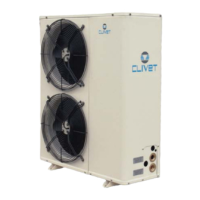Do you have a question about the CLIVET WSAN-EE 91 and is the answer not in the manual?
Defines the unit's designated purpose and provides general safety advice for users.
Identifies hazardous zones around the unit and risks associated with handling and installation.
Covers common operational hazards and specific risks related to the electrical system.
Provides specific safety data and handling instructions for R-410A refrigerant.
Highlights risks associated with the water circuit and potential refrigerant leaks.
Specifies required clearances for operation and maintenance, and placement guidelines.
Covers safety and design principles for connecting the unit to the electrical supply.
Provides technical specifications for power input, current, and other electrical data for various unit sizes.
Step-by-step instructions for safely connecting the unit to the electrical power grid.
Lists essential checks for the unit, refrigerant, water, and electrical systems before initial start-up.
Details final electrical system checks and procedures for activating crankcase heaters.
Verifies tensions, absorptions, compressor direction, and refrigerant circuit parameters.
Ensures correct water flow rate and checks key parameters of the refrigerant circuit.
Details functions for compensating and correcting set points based on external factors for efficiency.
Describes how alarms are indicated (flashing/fixed LED) and the procedure to reset them.
Classifies alarms and provides procedures for identifying and resetting them.
A comprehensive list of alarm codes and their potential causes for effective troubleshooting.
Details the recommended frequency and scope of maintenance inspections.
Provides tables with data for testing and verifying the operation of the refrigerant circuit.
Lists potential causes for high and low pressure alarms during cooling operation.
Guides on diagnosing and resolving issues related to faulty probes and pressure transducers.
Identifies common faults and protection mechanisms for the compressor, fan, and pump.
Details potential causes for high/low pressure and other operational issues specific to heating mode.
Outlines the steps for safely disconnecting the unit from power and refrigerant circuits.
Provides instructions for the proper dismantling and disposal of the unit.
Capacity, power input, EER, COP, and compressor details.
Defines the unit's designated purpose and provides general safety advice for users.
Identifies hazardous zones around the unit and risks associated with handling and installation.
Covers common operational hazards and specific risks related to the electrical system.
Provides specific safety data and handling instructions for R-410A refrigerant.
Highlights risks associated with the water circuit and potential refrigerant leaks.
Specifies required clearances for operation and maintenance, and placement guidelines.
Covers safety and design principles for connecting the unit to the electrical supply.
Provides technical specifications for power input, current, and other electrical data for various unit sizes.
Step-by-step instructions for safely connecting the unit to the electrical power grid.
Lists essential checks for the unit, refrigerant, water, and electrical systems before initial start-up.
Details final electrical system checks and procedures for activating crankcase heaters.
Verifies tensions, absorptions, compressor direction, and refrigerant circuit parameters.
Ensures correct water flow rate and checks key parameters of the refrigerant circuit.
Details functions for compensating and correcting set points based on external factors for efficiency.
Describes how alarms are indicated (flashing/fixed LED) and the procedure to reset them.
Classifies alarms and provides procedures for identifying and resetting them.
A comprehensive list of alarm codes and their potential causes for effective troubleshooting.
Details the recommended frequency and scope of maintenance inspections.
Provides tables with data for testing and verifying the operation of the refrigerant circuit.
Lists potential causes for high and low pressure alarms during cooling operation.
Guides on diagnosing and resolving issues related to faulty probes and pressure transducers.
Identifies common faults and protection mechanisms for the compressor, fan, and pump.
Details potential causes for high/low pressure and other operational issues specific to heating mode.
Outlines the steps for safely disconnecting the unit from power and refrigerant circuits.
Provides instructions for the proper dismantling and disposal of the unit.
Capacity, power input, EER, COP, and compressor details.











